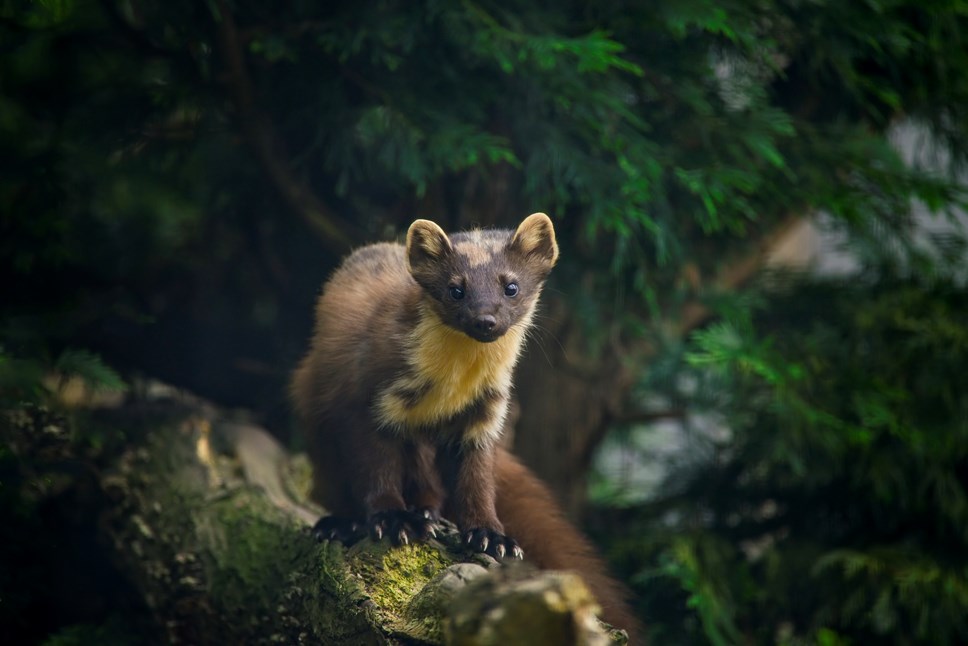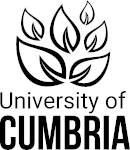
Rare species returns to Cumbria
The first confirmed sighting of a pine marten in south Cumbria for over a decade has been recorded on a remote camera in Grizedale Forest.
The species, an elusive member of the weasel family, is now largely found in Scottish woodland habitats, but evidence from local place names and hunting records suggests they were common in Cumbria until the late 19th century before declining as habitats decreased and they were hunted as vermin. As knowledge of and attitudes towards native wildlife have developed, the importance of pine martens to the wider forest ecosystem is now better understood and celebrated.
Monitoring of pine martens in south Cumbria is well-established, with surveys carried out as part of an exciting partnership project co-ordinated by the University of Cumbria – Back on our Map (BOOM), supported by The National Lottery Heritage Fund. Over the past three years the BOOM team has completed a feasibility study alongside Forestry England, Graythwaite Estate, Cumbria Wildlife Trust and other partners to consider the best approach to restore a healthy, breeding population of pine martens to the south of the county.
Surveys are ongoing, with initial positive results highlighting extensive suitable woodland habitats to meet the needs of a growing pine marten population. The team have also been buoyed by positive feedback from the local community. Ed Sandys, the manager of Graythwaite Estate in the Rusland Valley commented:
“As a boy, my father remembers black grouse on the fells and red squirrels in all the woodlands. We have lost so much but we are starting to see the return of species through dedicated conservation efforts. We are extremely excited that a pine marten has been seen in our area and must maintain momentum to assist in the recovery of our endangered wildlife.
However, there is still a long way to go to ensure the species is firmly re-established. Mic Mayhew, BOOM Project Officer, says:
"Our research shows that that pine martens moving south face serious obstacles, including the M6 motorway, and it is likely to be decades before we have a viable breeding population in south Cumbria. The best way to recover populations will involve the release of additional animals trapped under licence in Scotland - known as a translocation.”
To support the next stages of this project, a group of foresters, landowners and conservationists have recently come together to form a working group and develop the next stage of pine marten recovery.
The group has ambitious plans to increase engagement with local communities through public events and to expand native woodland cover through ground-breaking initiatives such as the Restoring Hardknott Forest project in the Duddon Valley. Creating new woodlands and also connecting existing habitats will help benefit pine martens translocated from Scotland and individuals moving south into the county.
Tom Dearnley, Ecologist with Forestry England said “Seeing pine marten return to South Cumbria is a landmark event in nature recovery which we are all delighted to witness. The prediction was that a small number of these inspiring mammals could reach South Cumbria independently, confirmation means we have solid foundations to build on and wonderful images to help engage this project with a wider community of people.
Notes to editors
Notes to Editor
Images attached
- Pine marten caught on camera (Forestry England/Crown Copyright)
- Pine marten (stock image)
- Forestry England manages and cares for the nation’s 1,500 woods and forests, with over 363 million visits per year. As England’s largest land manager, we shape landscapes and enhance forests for people to enjoy, wildlife to flourish and businesses to grow. We are continuing the work we have already started to make the nation’s forests resilient to climate change and by 2026 we will:
- create at least 6,000 more hectares where we integrate wilding activities in our productive forests.
- increase the diversity of visitors to the nation’s forests and have one million hours of high-quality volunteer time given to the nation’s forests
- plant at least 2,000 hectares of new, high quality, predominantly broadleaf woodlands
For more information visit forestryengland.uk. Forestry England is an agency of the Forestry Commission.
Back On Our Map is a project aiming to reintroduce 10 species into South Cumbria with local communities, led by University of Cumbria and Morecambe Bay Partnership.
Follow BOOM @BoomCumbria on Twitter, facebook.com/BackOnOurMap, Instagram/back_on_our_map
The National Lottery Heritage Fund has provided BOOM with funding to the tune of £1 million www.heritagefund.org.uk
About The National Lottery Heritage Fund
Using money raised by the National Lottery, we inspire, lead and resource the UK’s heritage to create positive and lasting change for people and communities, now and in the future.
Follow @HeritageFundUK on Twitter, Facebook and Instagram and use #NationalLotteryHeritageFund

